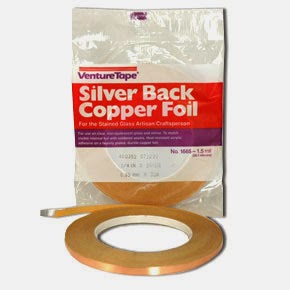Plating, also called overlay in stained glass terminology, involves using more than a single layer of stained glass in your projects. The Plating of stained glass together allows you the freedom to use any color or texture combination.
Each layer of stained glass is soldered on top of other layers to provide a variety of three dimensional effects.
Plating is not commonly practiced in the construction of stained glass suncatchers for several reasons.
First and foremost, when viewed from the front, stained glass plating looks great. However, when viewed from the back of the suncatcher or panel, plating looks much less aesthetic, in fact it can look plain ugly. This is because most plating occurs on the reverse of the suncatcher or panel.
Many stained glass artisans shy away from plating for a variety of reasons, but why do they bother with plating in the first place? Well, there are several reasons.
Plating transforms an otherwise common piece of work into a truly unique, "one of a kind" work of art like the example below that was created by Chuck Franklin Studios.
 |
| Waterfall Window |
Typical of stained glass done by Tiffany studios in the early 1900′s, this window features plating and the attaching of pieces to the front of the window to give it a 3-D effect. The plating of several layers of glass on top of each other produces the rich colors and depth. The logs in the foreground were rounded and protruded from the rest of the window.
When done properly, plating adds a sense of distance to a piece. It will also make your solder or lead lines look less distinct.
Plating can also be used to add "shading" and other effects to your piece.
Plating glass together does not restrict you to a single color, texture or type of stained glass. You can superimpose images on top of each other using different types of stained glass to achieve many desired effects.
To create the effect of "distance" to a piece, the layer closest to the viewer should be a thick, dense, opal glass. A dense glass diffuses the light that passes through the various layers and gives the desired diffused look.
A lot of Tiffany panels have been made with this effect.
When you want to add shading to your piece, you need a relatively dense glass or the lines become too pronounced.
When superimposing images on top of each other, you need to complete the background first. The second, "plating layer" is then superimposed on top of the completed background to create a sculptured effect that when done correctly will not have lead lines.
Another three dimensional effect that can be created by plating is a "faceted" or "ragged" effect.
To achieve this effect, multiple layers of stained glass are placed over each other. The best "faceted" effect can be achieved by organizing the different plated layers to give them a "more intense" look. The layers absorb more light and should cast shadows on other parts of the work.
You can make any piece look "rougher" by varying the angles of the plated glass on the upper layers.
There are some problems associated with Plating stained glass; accurate cuts, moisture, and weight distribution being the most prominent.
Depending on the pattern, accurate cuts become central to Plating stained glass projects; especially when one layer needs to be placed exactly on top of another layer.
Moisture can also be a problem when two layers are placed exactly on top of each other, however both problems can easily be handled by making accurate cuts and thoroughly drying each layer before soldering. When constructing layers, dry each layer thoroughly with a hair dryer as you build up your project.
You can also allow residual moisture to escape by providing a "vent" between layers is the layers are large. This can be done by putting a dollop of Vaseline on the top and bottom of the plated piece before soldering. The Vaseline stops the solder from holding at these locations and allows for the release of moisture that can build up and destroy the look of your project.
Occasionally the soldering flux will spit or spatter between the layers during soldering. When this happens, you have to de-solder the piece, clean it, and re-solder.
Another problem with multilayer plating is that it becomes almost impossible to lay the project flat on your work surface to solder. To keep your project level during soldering, you need to support the various layers of stained glass from underneath so the weight of the panel is equally distributed.
When plating only a few areas of a wall hanging or a panel, you need to take into account the weight distribution of the completed panel. The weight of the panel is no longer carried through the vertical plane of the glass.
When adding smaller more complex curves and shapes to a piece, it is more likely to have the necessary strength than when you add longer, narrower pieces which are more likely to bow or "warp". Since most stained glass Platings are a work in progress, add curves to your design to provide strength to the project.
You will encounter major weight distribution problems when the bottom portion of the panel is constructed from a single layer of glass and the upper portion is a multilayer construction. The entire project will be top heavy.
You can solve the problem by adding a clear piece of glass plate to the back of the piece, on the very bottom, to offset the weight distribution. You will have problems if you decide to frame the piece, but you can always carve away the bottom section of a frame to accommodate the increased width if you are using a wooden frame.
Because of the complexity of their design, most plated stained glass pieces have no set pattern. Their designs are modified while under construction, usually with the aid of light boxes.
If you decide to experiment with Plating, you can either start with an existing panel and add a layer or two, or start with a design of your own and add to it as the project grows. Get a base design and add a layer or two. Try out different types and color combinations until you are happy with your outcome.
When plating onto an existing panel, reduce the solder lines on the back of the panel to a flat line. Then cut the plating pieces and solder them onto the panel.
Plating is to some extent a trial and error process. Take your time and experiment with it. You will be surprised with the results you can achieve.






















